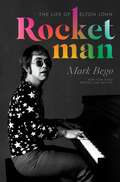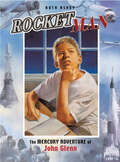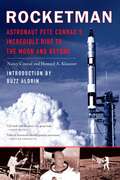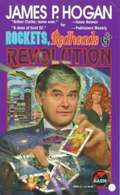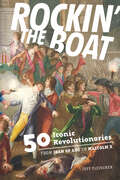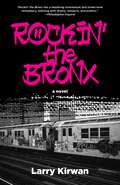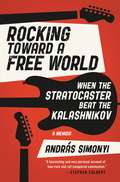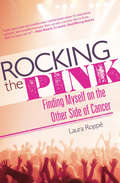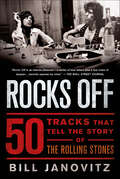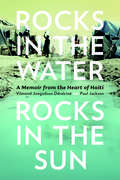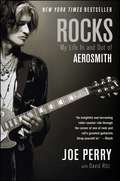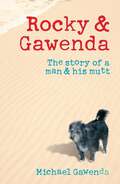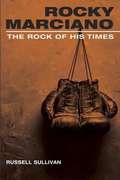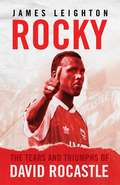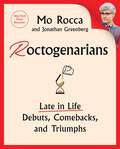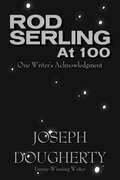- Table View
- List View
Rocket Man: The Life Of Elton John
by Mark BegoThe colorful and kaleidoscopic life of one of the world’s most original and talented musical artists. Here’s the book every pop music lover has been waiting for—full of the scandals, addictions, affairs, and tantrums that underscored the life of arguably the world’s greatest pop musician. Flamboyant, iconic Elton John is as much part of the American musical landscape as he is in his native England. In the 1970s, when popular music on both sides of the Atlantic fragmented into disco, soul, hard rock, pop, and folk, Elton John embraced them all with his signature creative panache. Emerging in the late 1960s as a singer/songwriter, Elton was widely acknowledged as the most prolific pop and rock star of the decade by the mid-1970s. His peerless musical style and ability to jump from sensitive ballads to bawdy rock anthems to campy pop have made him a musical superstar for the ages. From his heartfelt ballads like “Tiny Dancer” and “Your Song” to his rock & roll hits including “Bennie and the Jets” and “Crocodile Rock,” Elton has lived one of the most outrageous and colorful lives in show business. Having met the “Rocket Man” the first time in the 1980s, Bego has drawn upon his personal observations and vast research, and has been able to interview dozens of Elton’s collaborators and lifelong friends to produce the the ultimate story on the amazing and larger-than-life Elton John.
Rocket Man: The Mercury Adventure of John Glenn
by Ruth AshbyOn February 20, 1962, as millions of Americans waited anxiously, astronaut John Glenn blasted off in his rocket ship, Friendship 7, and became the first American to orbit the Earth.Although the risks of such a mission for Friendship 7 were well known, no one including Glenn knew the peril he was about to encounter in space. John Glenn was one of the Mercury 7 astronauts, the early pioneers of manned space flight. His historic flight followed years of intensive physical training and a devotion to a career in the exciting but risk-filled world of aviation.Ruth Ashby's dramatic story of John Glenn's near-disastrous mission in Friendship 7 also takes young readers through his small-town Ohio childhood, his extraordinary experiences as a fighter pilot in two wars, and his life as an astronaut in the prestigious and dangerous Mercury 7 program. The book concludes with Glenn's successful career as a US senator and his triumphant return to space in 1998 at the age of 77.
Rocket Men
by Ron Haslam Leon Haslam'Rocket' Ron Haslam started racing on the professional circuit in 1972 at the age of 15 and developed into one of the finest, and fastest, racers the UK has ever seen. Winner of three World titles and four British championships, as well as a record six Macau GPs, he rode in more than 100 Grands Prix. Despite tragically losing two of his brothers in motorbike accidents, Haslam kept on riding, setting speed records wherever he went.His son, Leon, the 'Pocket Rocket', is following in his father's extremely speedy footsteps. A national Motorcross champion and national Scooter champion at the age of just 14, he became the youngest ever rider to compete in the 500cc World Championship and is now one of Britain's top racers, competing for Stiggy Honda in the World Superbike Championship.This is the extraordinary story of a father and a son who are addicted to motorbikes, with all the thrills and spills, miraculous escapes and multiple broken bones that involves. Both colourful characters, their story takes us all the way from the 1970s to today and is full of hilarious high-octane derring-do, a cast of characters including legends like Fast Freddie Spencer and Barry Sheene, and nothing less than terrifying but exhilarating adventure.
Rocketman
by Nancy ConradWhether he was hot-dogging at Mach 2, test-flying every supersonic jet the Navy developed (and some they shouldn't have), orbiting the Earth at almost 20,000 mph, or redlining his Corvette, Pete Conrad loved pushing the envelope. The guy every NASA pilot wanted to happyhour with after work-and would kill to fly with-Pete had a natural outspokenness that got him removed from the Mercury program. But the Comeback Kid came roaring back-flying two Gemini missions, walking on the Moon as the commander of Apollo 12, commanding the first Skylab, and logging more time in space than all the original astronauts combined. This is a surprisingly candid insider's view of the greatest ride in history: America's glorious race to the stars, as seen through the eyes of a real space cowboy.
Rockin' the Boat: 50 Iconic Revolutionaries — From Joan of Arc to Malcom X
by Jeff FleischerWe love to root for the underdog, and when it comes to underdogs, few are more impressive than the world’s great revolutionaries.After all, it’s pretty hard to find a more powerful opponent than the world’s biggest empires and emperors. And that’s part of why we’re drawn to the stories of revolutionaries. Many of these men and women were born into virtual dystopias, and they fought throughout their lives, against all odds, to forge a path to a better future. And whether they succeeded, failed, or succeeded only to become a new kind of enemy, there’s something inherently fascinating about that effort to change the world.
Rockin' the Bronx
by Larry KirwanDiscover the untold story of 1980s Irish New York, where love, politics, and rock 'n' roll collide in a gritty urban tale that's as passionate as it is poignant.Rockin’ The Bronx vividly transports readers to the vibrant and chaotic world of 1980s Bronx, where Irish immigrants forged a new community amidst the backdrop of political upheaval and cultural transformation. Larry Kirwan, leader of the revolutionary band Black 47, blends drama, passion, and musical evolution into a narrative that captures the essence of an era defined by its challenges and triumphs. Through the eyes of characters like the groundbreaking gay hero, a book-loving, hard-hitting immigrant with IRA roots, and the central couple, Seán and Mary, who navigate this raucous landscape, Kirwan explores the intersecting worlds of personal identity and communal struggle. Set during significant historical moments—the deaths of John Lennon and Bobby Sands, the AIDS crisis, and the birth of new musical movements—this novel not only tells the story of its characters but also of a neighborhood echoing with the rhythms of change. As these Irish immigrants carve out their destinies, they leave behind a legacy of resilience and rebirth, encapsulated in a narrative that moves irrepressibly to the beat of the 1980s. Rockin' The Bronx is more than a novel; it’s a chronicle of a time when being Irish in New York could mean everything from strapping on a Stratocaster to knocking down walls both structural and cultural." data-fwclientid="8689d109-65f9-4971-bf1f-858e6c13ac9c" data-preservehtmlbullets="1" data-allowlists="0" data-crlfsubmit="1" autocomplete="off" spellcheck="true" class="field_input_main field_input_copytext field_input_copytext_body copytextheight-normal field_input_disabled fieldkeycheck-setup copytext-setup" contenteditable="false">Discover the untold story of 1980s Irish New York, where love, politics, and rock 'n' roll collide in a gritty urban tale that's as passionate as it is poignant.Rockin’ The Bronx vividly transports readers to the vibrant and chaotic world of 1980s Bronx, where Irish immigrants forged a new community amidst the backdrop of political upheaval and cultural transformation. Larry Kirwan, leader of the revolutionary band Black 47, blends drama, passion, and musical evolution into a narrative that captures the essence of an era defined by its challenges and triumphs. Through the eyes of characters like the groundbreaking gay hero, a book-loving, hard-hitting immigrant with IRA roots, and the central couple, Seán and Mary, who navigate this raucous landscape, Kirwan explores the intersecting worlds of personal identity and communal struggle. Set during significant historical moments—the deaths of John Lennon and Bobby Sands, the AIDS crisis, and the birth of new musical movements—this novel not only tells the story of its characters but also of a neighborhood echoing with the rhythms of change. As these Irish immigrants carve out their destinies, they leave behind a legacy of resilience and rebirth, encapsulated in a narrative that moves irrepressibly to the beat of the 1980s. Rockin' The Bronx is more than a novel; it’s a chronicle of a time when being Irish in New York could mean everything from strapping on a Stratocaster to knocking down walls both structural and cultural.
Rocking Toward a Free World: When the Stratocaster Beat the Kalashnikov
by András SimonyiFrom renowned diplomat and musician András Simonyi -- whom Stephen Colbert calls "the only ambassador I know who can shred a mean guitar!" -- comes a timely and revealing memoir about growing up behind the Iron Curtain and longing for freedom while chasing the great power of rock and roll. p.p1 {margin: 0.0px 0.0px 0.0px 0.0px; text-indent: 36.0px; font: 12.0px Arial} In ROCKING TOWARD A FREE WORLD, Simonyi charts the struggle of growing up in 1960s Hungary, a world in which listening to his favorite music was a powerful but furtive endeavor: records were black-market bootlegs; concerts were held under strict control, even banned; protests were folded into song lyrics. Get caught listening to Western radio could mean punishment, maybe prison. That didn't matter to Simonyi, who from an early age felt the tremendous pull of rock and roll, the lure of American popular culture, and a burning desire to buck the system. Inspired by the protest music coming out of the West, he formed a band and became part of Hungary's burgeoning rock scene. Then came the setbacks: tightening of control by the state, the seemingly inescapable weight of an authoritarian system, and the collapse of Simonyi's own dreams of stardom. A story of youth, rebellion, and hope, ROCKING TOWARD A FREE WORLD sheds new light on two of the most powerful forces of the modern age: global democracy and rock and roll. Deeply vital and compelling, Simonyi's memoir chronicles how one man's tremendous connection to American and British popular music inspired him to make a difference in his country and, eventually, the world. It tells the story of a generation, as played out in song lyrics and guitar riffs. p.p1 {margin: 0.0px 0.0px 0.0px 0.0px; font: 13.0px Times} p.p2 {margin: 0.0px 0.0px 0.0px 0.0px; font: 13.0px Times; min-height: 16.0px}
Rocking the Pink: Finding Myself on the Other Side of Cancer
by Laura RoppeIn 2008, just as Laura Roppé was poised to burst onto the music scene, her doctor called her with news that left her spinning—she had been diagnosed with an extremely aggressive form of breast cancer. Just days earlier, she had signed a dream-come-true contract with a record label; now, she wasn’t even sure how much longer she had to live. Never one to back down to a challenge, however, Roppé gathered her courage, took stock of her priorities, and made a decision: Cancer may take my hair, she told herself, but that’s all it’s getting. More than a cancer journey, Rocking the Pink is a quirky, charming, and poignant ode to love, friendship, and music. Roppé is unflinchingly honest and unfailingly funny as she tells the story of her odyssey: from childhood dreamer and giddy valet parker to the Hollywood stars to disillusioned lawyer, wife, and mother; from budding songwriter and late-blooming recording artist to determined cancer survivor. Full of raw emotion and humor that will make you laugh through your tears, Rocking the Pink is a chronicle of discovering one's true self through life’s difficult circumstances—and a testament to the hang-in-tough, take-no-prisoners attitude it takes to kick cancer’s butt.
Rocks
by David Ritz Joe PerryIn this riveting inside account of his life in rock-and-roll band Aerosmith, Joe Perry opens up for the first time to tell the story of his wild, unbridled life as the band's lead guitarist. He delves deep into his volatile, profound, and enduring relationship with singer Steve Tyler, and reveals the real people behind the larger-than-life rock-gods on stage. It's an intimate account of nearly five decades of mega highs and heartbreaking lows. The story of Aerosmith is not your average rock-and-roll tale. It's an epic saga, at once a study in brotherhood and solitude that plays out on the killing fields of rock and roll. With record-making hits and colossal album sales that compete with legends such as U2 and Frank Sinatra, Aerosmith has earned their place in the Rock and Roll Hall of Fame. But with a sweeping comeback in the late 80s, one can see there is a bigger story here: to come back that high, you have to have plummeted pretty low. Aerosmith's game with fame is one of success, failure, rebirth, re-destruction, even the post-destructive rebirth, but here they are today, in their 60s and still on top. ROCKS is ultimately a story of endurance, and it starts almost half a century ago with young Perry, the misanthrope whose loving parents practically begged him to assimilate, but who quits school because he doesn't want to cut his hair. He meets Tyler in a restaurant in Boston, sways him from pop music to the darker side, rock-and-roll, and it doesn't take long for the "Toxic Twins" to skyrocket into a world of fame, drugs, and utter excess. Perry takes fora personal look into the two stars behind Aerosmith, the people who enabled them, the ones who controlled them, and the ones who changed them.
Rocks Off: 50 Tracks That Tell the Story of the Rolling Stones
by Bill JanovitzDecember 3-4, 1969. Keith and Mick stood at the same microphone at Muscle Shoals, lights dimmed, splitting a fifth of bourbon, and simultaneously sang the melodies and harmonies on the three songs that they had recorded over three days: "Brown Sugar," "You Got to Move," and "Wild Horses." That's your rock ‘n' roll fantasy right there, pal. A six-piece band working in a tiny converted coffin factory across from an Alabama graveyard, on an eight-track recorder, with no computer editing or Autotune, recorded three songs, representing 30 percent of one of the greatest rock ‘n' roll records of all time.So tells Bill Janovitz of the making of the inimitable triple-platinum album, Sticky Fingers, which hit number one in the US and the UK in 1971, skyrocketing the band to superstardom.To Bill, all artists reveal themselves through their work and the Rolling Stones are no different: Each song exposes a little more of their soul. In Rocks Off, Janovitz reveals the forces at work behind the band's music by deconstructing their most representative tunes from their incredible fifty years of record making. Written by a Stones fanatic, this is a song-by-song chronicle that maps the landmarks of the band's career while expanding on their recording and personal history. Much like friends pouring over old records or having a barroom argument over the merits of certain songs, the book presents the musical leaps taken by the band and discusses how the lyrical content both reflected and influenced popular culture. The song choices are chronological and subjective; many of them are the classic hits; however, the book digs deeper into beloved album tracks and songs with unique stories behind them.Rocks Off is the ultimate listening guide and thinking man's companion that will spur you to dust off those old albums and listen in with a newfound perspective on one of the most famous and acclaimed rock 'n' roll bands of all time.
Rocks in the Water, Rocks in the Sun: A Memoir from the Heart of Haiti
by Paul Jackson Vilmond Joegodson DéralcinéWhen Joegodson Déralciné was still a small child, his parents left rural Haiti to resettle in the rapidly growing zones of Port-au-Prince. As his family entered the city in 1986, Duvalier and his dictatorship exited. Haitians, once terrorized under Duvalier’s reign, were liberated and emboldened to believe that they could take control of their lives. But how? Joining hundreds of thousands of other peasants trying to adjust to urban life, Joegodson and his family sought work and a means of survival. But all they found was low-waged assembly plant jobs of the sort to which the repressive Duvalier regime had opened Haiti’s doors—the combination of flexible capital and cheap labour too attractive to multinational manufacturers to be overlooked. With the death of his mother, Joegodson was placed in his uncle’s care, and so began a childhood of starvation, endless labour, and abuse. In honest, reflective prose, Joegodson—now a father himself— allows us to walk in the ditches of Cité Soleil, to hide from the macoutes under the bed, to feel the ache of an empty stomach. But, most importantly, he provides an account of life in Haiti from a perspective that is rarely heard. Free of sentimentality and hackneyed clichés, his narrative explores the spirituality of Vodou, Catholicism, and Protestantism, describes the harrowing day of the 2010 earthquake and its aftermath, and illustrates the inner workings of MINUSTAH. Written with Canadian historian Paul Jackson—Joegodson telling his story in Creole, Jackson translating, the two of them then reviewing and reworking—the memoir is a true collaboration, the struggle of two people from different lands and vastly different circumstances to arrive at a place of mutual understanding. In the process, they have given us an unforgettable account of a country determined to survive, and on its own terms.
Rocks: My Life in and out of Aerosmith
by Joe PerryJoe Perry’s New York Times bestselling memoir of life in the rock-and-roll band Aerosmith: “An insightful and harrowing roller coaster ride through the career of one of rock and roll’s greatest guitarists. Strap yourself in” (Slash).Before the platinum records or the Super Bowl half-time show or the Rock and Roll Hall of Fame, Joe Perry was a boy growing up in small-town Massachusetts. He idolized Jacques Cousteau and built his own diving rig that he used to explore a local lake. He dreamed of becoming a marine biologist. But Perry’s neighbors had teenage sons, and those sons had electric guitars, and the noise he heard when they started playing would change his life. The guitar became his passion, an object of lust, an outlet for his restlessness and his rebellious soul. That passion quickly blossomed into an obsession, and he got a band together. One night after a performance he met a brash young musician named Steven Tyler; before long, Aerosmith was born. What happened over the next forty-five years has become the stuff of legend: the knockdown, drag-out, band-splintering fights; the drugs, the booze, the rehab; the packed arenas and timeless hits; the reconciliations and the comebacks. Rocks is an unusually searching memoir of a life that spans from the top of the world to the bottom of the barrel—several times. It is a study of endurance and brotherhood, with Perry providing remarkable candor about Tyler, as well as new insights into their powerful but troubled relationship. It is an insider’s portrait of the rock and roll family, featuring everyone from Jimmy Page to Alice Cooper, Bette Midler to Chuck Berry, John Belushi to Al Hirschfeld. It takes us behind the scenes at unbelievable moments such as Joe and Steven’s appearance in the movie of Sgt. Pepper’s Lonely Hearts Club Band (they act out the murders of Peter Frampton and the Bee Gees). Full of humor, insight, and brutal honesty about life in and out of one of the biggest bands in the world, Rocks is “well-paced, well-plotted…a mini-masterpiece” (The Boston Globe).
Rocky And Gawenda
by Michael GawendaMichael Gawenda is one of Australia's best known journalists and writers. Rocky is his small furry dog of indeterminate breeding, a mutt in other words. Rocky and Gawenda have been in a relationship for more than two years, since Rocky was eight weeks old and Gawenda just a bit older than that. They are best friends who are engaged in a conversation about dogs and love and memory and the meaning of work and the passing of time. Their relationship has matured in some unexpected ways. Rocky taught Gawenda how good it is to live in the moment. It is not clear what Gawenda has taught Rocky except that human beings can be moody and capricious and lost in their own thoughts. This record of their relationship, which was originally a popular blog, is funny, joyous, sad at times, and full of delightful surprises. It is a celebration of the love that developed between a dog and his human friend.
Rocky Marciano: The Rock of His Times (Sport and Society)
by Russell SullivanIn this captivating and complex portrait of an American sports legend, Russell Sullivan confirms Rocky Marciano's place as a symbol and cultural icon of his era. As much as he embodied the wholesome, rags-to-riches patriotism of a true American hero, he also reflected the racial and ethnic tensions festering behind the country's benevolent facade. Spirited, fast-paced, and rich in detail, Rocky Marciano is the first book to place the boxer in the context of his times. Capturing his athletic accomplishments against the colorful backdrop of the 1950s fight scene, Sullivan examines how Marciano's career reflected the glamour and scandal of boxing as well as tenor of his times.
Rocky Mountain High: A Tale Of Boom And Bust In The New Wild West
by Finn Murphy“Brim[s] with wit, pluck, and hard-won wisdom.” —Jessica Bruder, best-selling author of Nomadland The best-selling author of The Long Haul returns with the story of ditching his truck to seek his fortune…in hemp. After decades as a long-haul trucker, Finn Murphy left the road and settled in Boulder County, Colorado. Before long he noticed that many of his neighbors were captivated by the prospect of vast riches in “the Hemp Space.” When hemp was legalized, after eighty years in federal exile, Colorado became the center of a hemp growing and processing boom. Figuring he’d harvest some of that easy money, Murphy bought a thirty-six-acre farm. What could go wrong? Well, pretty much everything… Rocky Mountain High is the comic chronicle of a wild year as Murphy follows his Great American Dream, gradually losing his shirt but not his spirit. Pivoting away from growing hemp himself, he decides to make himself a middleman. He builds drying sheds the size of football fields. He battles with freezing temperatures and even colder bankers. And he assembles an eclectic crew of workers, including the wry and vastly talented Manuel, the business savvy Pierce, and a scruffy army of “trimmigrants”—specialized farm laborers who roam the country pursuing (or not) their own American Dreams. Pretty soon, Murphy is pitting his dwindling cash against the mercurial buyers who inhabit the Wild West of the hemp market. Told with Murphy’s trademark wit, keen eye for character, and sharp insights into the hardscrabble society around him, Rocky Mountain High is an inside look at the alluring world of the hemp boom and a masterful tale of one entrepreneur’s misadventures.
Rocky: The Tears and Triumphs of David Rocastle
by James LeightonIn spring 1998, David Rocastle was sitting in the stands at Highbury watching his beloved Arsenal close in on the Premier League title. On the pitch were many of those he had played with earlier in his career. But now, at the age of 30, when he should have been at his peak, injuries meant he was out of the game. Within three years, he would be dead after suffering from non-Hodgkin lymphoma, an aggressive form of cancer. It was a loss that devastated his family, and was keenly felt by team-mates and football fans across the country. James Leighton tells the extraordinary story of a boy whose footballing dreams all came true, but whose time at the top was cut short. When former Arsenal chairman David Dein first saw the 16-year-old Rocastle in action, he rushed home saying: 'I've seen the nearest thing to a Brazilian you'll ever see in our Academy - and he's from Lewisham!' A year later he was in the first XI, and by the time he was 20 he had won the League Cup. In 1989, he was part of the team that won the league title in the most dramatic circumstances, with virtually the last kick of the season. Rocastle moved on from Arsenal in 1992, but injuries increasingly hampered his career. Now, in Rocky, we hear from friends, family and team-mates what he was really like, on and off the field. As we do, we understand why it is that Arsenal fans still regularly chant his name almost 25 years since he left the club and why he is one of the select few to have their portraits permanently displayed on the exterior of the Emirates Stadium.
Roctogenarians: Late in Life Debuts, Comebacks, and Triumphs
by Mo Rocca Jonathan GreenbergFrom beloved CBS Sunday Morning correspondent Mo Rocca, author of New York Times bestseller Mobituaries, comes an inspiring collection of stories that celebrates the triumphs of people who made their biggest marks late in life. Eighty has been the new sixty for about twenty years now. In fact, there have always been late-in-life achievers, those who declined to go into decline just because they were eligible for social security. Journalist, humorist, and history buff Mo Rocca and coauthor Jonathan Greenberg introduce us to the people past and present who peaked when they could have been puttering—breaking out as writers, selling out concert halls, attempting to set land-speed records—and in the case of one ninety-year tortoise, becoming a first-time father. (Take that, Al Pacino!) In the vein of Mobituaries, Roctogenarians is a collection of entertaining and unexpected profiles of these unretired titans—some long gone (a cancer-stricken Henri Matisse, who began work on his celebrated cut-outs when he could no longer paint), some very much still living (Mel Brooks, yukking it up at close to one hundred). The amazing cast of characters also includes Mary Church Terrell, who at eighty-six helped lead sit-ins at segregated Washington, DC, lunch counters in the 1950s, and Carol Channing, who married the love of her life at eighty-two. Then there&’s Peter Mark Roget, who began working on his thesaurus in his twenties and completed it at seventy-three (because sometimes finding the right word takes time.) With passion and wonder Rocca and Greenberg recount the stories of yesterday&’s and today&’s strongest finishers. Because with all due respect to the Golden Girls, some people will never be content sitting out on the lanai. (PS Actress Estelle Getty was sixty-two when she got her big break. And yes, she&’s in the book.)
Rod
by Rod StewartRod Stewart was born the working class son of a Scottish plumber in north London. Despite some early close shaves with a number of diverse career paths ranging from gravedigging to professional soccer, it was music that truly captured his heart--and he never looked back.Rod started out in the early 1960s playing the clubs on London's R&B scene before his distinctively raspy voice caught the ear of the iconic front man Long John Baldry, who approached him while he was busking one night on a railway platform. Stints with pioneering acts like the Hoochie Coochie Men, Steampacket, and the Jeff Beck Group soon followed, paving the way into a raucous five years with the Faces, the rock star's rock band, whose onstage and offstage antics with alcohol, wrecked hotel rooms, partying, and groupies have become the stuff of legend. And during all this, he found a spare moment to write "Maggie May," among a few other tunes, and launch a solo career that has seen him sell in excess of 200 million records, be inducted into the Rock and Roll Hall of Fame twice, and play the world's largest-ever concert. Not bad, as he says, for a guy with a frog in his throat. And then there is his not-so-private life: marriages, divorces, and affairs with some of the world's most beautiful women--Bond girls, movie stars, and supermodels--a struggle with steroids, and a brush with cancer, in which he almost saw it all slip away. Rod's is an incredible life, and here-- thrillingly and for the first time--he tells the entire thing, leaving no knickers under the bed. A rollicking rock 'n' roll adventure that is at times deeply moving, this is the remarkable journey of a guy with one hell of a voice--and one hell of a head of hair.From the Hardcover edition.
Rod Serling at 100: One Writer's Acknowledgment
by Joseph DoughertyEmmy-winning writer and lifelong Rod Serling fan Joseph Dougherty (thirtysomething, Pretty Little Liars) takes a deep dive into the writing of the Twilight Zone creator on the occasion of his 100th birthday.The year 2024 marks the centenary of Rod Serling, creator of The Twilight Zone and Night Gallery. Emmy-winning writer Joseph Dougherty (thirtysomething, Pretty Little Liars) picked this special anniversary to reflect on Serling and his contributions to television drama. An appreciation and exploration of the six-time Emmy-winning writer&’s catalogue, Rod Serling at 100: One Writer&’s Acknowledgment looks at some of Serling&’s best known work and also some of his least acknowledged, inviting a new perspective on a master storyteller. In the process, Dougherty takes a personal look at the time he spent in The Twilight Zone that led to his own award-winning writing career
Rod Serling: His Life, Work, and Imagination
by Nicholas ParisiLong before anyone had heard of alien cookbooks, gremlins on the wings of airplanes, or places where pig-faced people are considered beautiful, Rod Serling was the most prestigious writer in American television. As creator, host, and primary writer for The Twilight Zone, Serling became something more: an American icon. When Serling died in 1975, at the age of fifty, he was the most honored, most outspoken, most recognizable, and likely the most prolific writer in television history. Though best known for The Twilight Zone, Serling wrote over 250 scripts for film and television and won an unmatched six Emmy Awards for dramatic writing for four different series. His filmography includes the acclaimed political thriller Seven Days in May and cowriting the original Planet of the Apes. In great detail and including never-published insights drawn directly from Serling’s personal correspondence, unpublished writings, speeches, and unproduced scripts, Nicholas Parisi explores Serling’s entire, massive body of work. With a foreword by Serling’s daughter, Anne Serling, Rod Serling: His Life, Work, and Imagination is part biography, part videography, and part critical analysis. It is a painstakingly researched look at all of Serling’s work—in and out of The Twilight Zone.
Rod Stewart: Autobiografía
by Rod StewartLa esperada autobiografía de Rod Stewart, el legendario cantante británico de rock and roll. Una juerga rocanrolera repleta de aventuras que en ocasiones resulta profundamente conmovedora; el extraordinario viaje de un tipo con una voz única, y una cabellera fenomenal. Rod Stewart nació en el norte de Londres en el seno de una familia de clase trabajadora, hijo de un fontanero escocés. A pesar de librarse por los pelos de carreras muy variadas, desde cavar tumbas hasta jugar en el fútbol profesional, lo que verdaderamente conquistó su corazón fue la música, y nunca se arrepintió. Rod empezó su carrera a principios de los años sesenta, tocando en los clubes de rhythm & blues de Londres, hasta que su particular voz ronca atrajo la atención del legendario vocalista Long John Baldry, que lo descubrió una noche durante una actuación en el andén del metro. Posteriormente, formó parte de grupos tan pioneros como los Hoochie Coochie Men, Steampacket y el Jeff Beck Group, que le allanaron el terreno para luego pasar cinco turbulentos años con los Faces, la banda de rock cuyos excesos con el alcohol, sus destrozos en las habitaciones de los hoteles y groupies los convirtieron en leyenda. Fue en ese periodo cuando sin embargo encontró un momento de paz para escribir «Maggie May», entre otras canciones, y emprender su carrera en solitario, que le ha llevado a vender unos doscientos millones de copias, a ser incluido dos veces en el Salón de la Fama del Rock and Roll y a tocar en el concierto más multitudinario de la historia. Como él dice, no está mal para un tío con la voz tan áspera. Por otra parte, nos describe su vida «no tan privada»: matrimonios, divorcios y aventuras amorosas con algunas de las mujeres más guapas del mundo -chicas Bond, actrices y supermodelos-, además de su escaramuza con un cáncer que amenazó con acabar con todo aquello. La vida de Rod Stewart es increíble y, en este libro, de forma emocionante y por primera vez, nos cuenta toda la historia, sin esconder los trapos sucios.
Rod Stewart: autobiografía
by Rod StewartRod Stewart nació en el norte de Londres en el seno de una familia de clase trabajadora, hijo de un fontanero escocés. A pesar de librarse por los pelos de carreras muy variadas, desde cavar tumbas hasta jugar en el fútbol profesional, lo que verdaderamente conquistó su corazón fue la música, y nunca se arrepintió.Rod empezó su carrera a principios de los años sesenta, tocando en los clubes de rhythm & blues de Londres, hasta que su particular voz ronca atrajo la atención del legendario vocalista Long John Baldry, que lo descubrió una noche durante una actuación en el andén del metro. Posteriormente, formó parte de grupos tan pioneros como los Hoochie Coochie Men, Steampacket y el Jeff Beck Group, que le allanaron el terreno para luego pasar cinco turbulentos años con los Faces, la banda de rock cuyos excesos con el alcohol, sus destrozos en las habitaciones de los hoteles y groupies los convirtieron en leyenda. Fue en ese periodo cuando sin embargo encontró un momento de paz para escribir «Maggie May», entre otras canciones, y emprender su carrera en solitario, que le ha llevado a vender unos doscientos millones de copias, a ser incluido dos veces en el Salón de la Fama del Rock and Roll y a tocar en el concierto más multitudinario de la historia. Como él dice, no está mal para un tío con la voz tan áspera.Por otra parte, nos describe su vida «no tan privada »: matrimonios, divorcios y aventuras amorosas con algunas de las mujeres más guapas del mundo ?chicas Bond, actrices y supermodelos, además de su escaramuza con un cáncer que amenazó con acabar con todo aquello.La vida de Rod es increíble y, en este libro, de forma emocionante y por primera vez, nos cuenta toda la historia, sin esconder los trapos sucios. Una juerga rocanrolera repleta de aventuras que en ocasiones resulta profundamente conmovedora; el extraordinario viaje de un tipo con una voz única, y una cabellera fenomenal.
Rodeo Stories: A Collection Of True Cowboy Tales
by Chimp Robertson[Proofreader's Note: This text had many errors throughout. They were left in place due to copyright laws.] Chimp Robertson has put together an anthology of rodeo stories from the famous and not so famous. Each story was written by the individual rodeo rider, and ranges from flat out funny, to pathos, to "glad that wasn't me", to. . . Every story sits tall in the saddle on its own merits, but put them all together and Chimp has created a fireside reader that will keep you entertained for hours; a great book to travel with, as a gift or to take to your next rodeo for autographs. Every rodeo cowboy/cowgirl has at least one incredible rodeo story, and Rodeo Stories relates some of the best ones. This book not only makes the 8 second buzzer, but it wins the championship belt buckle. Pull your cowboy hat on tight, nod your head to open the gate, and hang on for a great ride! Robert Lorbeer
Rodigan: My Life in Reggae
by David Rodigan'THE BOOK THAT EVERY REGGAE FAN SHOULD READ' John Masouri, Echoes'Rodigan can still claim a currency few presenters of his vintage can match. Perhaps it's because while his wider musical and professional milieu has been in constant change, his boundless enthusiasm has been constant. Reggae's been lucky to have him' Ian Harrison, MOJO'Rodigan was a major part of my childhood, he played the hottest tunes and in a style that just resonated with me and millions like me. Being able to contribute anything to a man that filled my life with such joy is an honour, respect, David Rodigan' Ian Wright'David is a pioneer in Reggae music. As a selector and radio personality, his vast knowledge of Jamaican music and its culture has helped to educate and fascinate music lovers around the world; he's an amazing son of the music, and an icon. We couldn't have made it this far without him' ShaggyThis is the unlikely story of David Rodigan: an Army sergeant's son from the English countryside who has become the man who has taught the world about Reggae. As the sound of Jamaica has morphed over five decades through a succession of different genres - from Ska and Rock Steady, to Dub, Roots and Dancehall - Rodigan has remained its constant champion, winning the respect of generation after generation of Reggae followers across the globe.Today, at the age of 63, he is a headline performer at almost all the UK's big music festivals, as well as events across the world. Young people revere him and he is a leading presenter on the BBC's youth network 1Xtra as well as a regular fixture at leading nightclubs such as London's Fabric and at student unions throughout the land. And he continues to go into the heartlands of Reggae, to the downtown dancehalls of Kingston and Montego Bay in Jamaica to compete in tournaments against the greatest sound systems. And yet, for all of this, David Rodigan is the antithesis of the stereotype of an international dance music DJ. 'I look like an accountant or a dentist,' he admitted to The Independent a decade ago. A man of impeccable manners, Rodigan prepares for a big sound clash by retiring to his hotel bed with a Thomas Hardy novel before taking a nap and then a cup of espresso before heading to the club. Rodigan is the inside story of this apparent paradox. It tells how a boy from Kidlington has become an admired international ambassador for a music form that remains as proud as ever of its African roots, a sound that emanates from and fiercely represents the ghetto poor. He now reaches across the age groups, from teens through to those of his own vintage. At the pinnacle of his career, Rodigan has become the DJ for all generations.'David Rodigan is a force of nature. His spirit and passion are a rare and wonderful thing. He has dedicated his life to carrying the torch for Reggae music and is hugely respected all over the world for his knowledge and talent as a broadcaster and a DJ. Long may he reign on our stages and on our airwaves' Annie Mac
